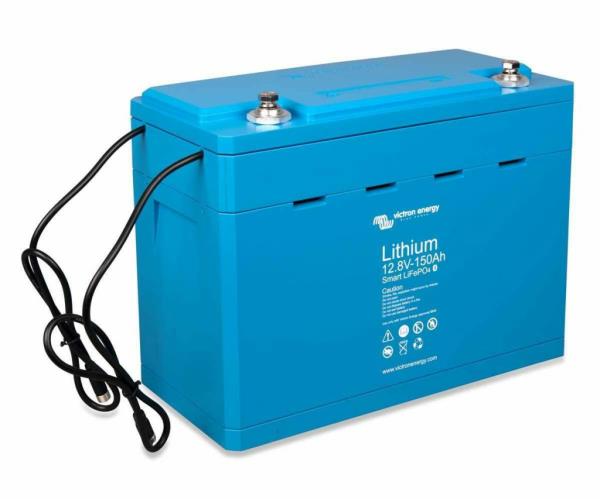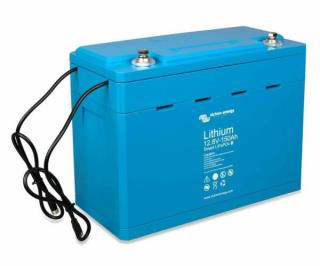El sol es nuestro aliado
Baterías Estacionarias - Sonnenschein
Lithium Battery 12,8V + 25,6V
Victron Energy
CODESOLAR
ENERGIA
S. A.
CS
12.8V & 25.6V Smart Lithium Battery
- With integrated cell balancing
- Can be connected in series and in parallel
- Bluetooth app available to monitor cell voltage and temperature
Smart lithium battery
The Smart lithium battery is a lithium iron phosphate (LiFePO4 or LFP) battery, the safest among conventional lithium batteries.
The Smart lithium battery is available in two voltages, 12.8 V and 25.6 V. A single LFP cell has a nominal voltage of 3.2 V. A 12.8 V battery consists of 4 cells connected in series and a 25.6 V battery consists of 8 cells connected in series. (see 1*)
The chemical composition of LFPs is the right choice for very demanding applications. Some of its properties are:
- High full cycle efficiency.
- High energy density - More capacity with less weight and less volume.
- High charging and discharging currents, which allow fast charging and discharging.
- Flexible charging voltages.

Smart lithium battery range
Smart lithium batteries are available with different capacities and two different voltages: 12.8 V and 25.6 V. These are the battery models available:
- 12.8V/50Ah Smart LiFePO4 Battery
- 12.8V/100Ah Smart LiFePO4 Battery
- 12.8V/160Ah Smart LiFePO4 Battery
- 12.8V/200Ah Smart LiFePO4 Battery
- 12.8V/330Ah Smart LiFePO4 Battery
- 25.6V/100Ah Smart LiFePO4 Battery
- 25.6V/200Ah Smart LiFePO4 Battery
CodeSolarEnergia S. A.
Quito, Ecuador, Sudamerica
Requires one of these BMS-es:
VE. Bus BMS / VE.Bus BMS V2 – recommended for systems with our inverter/chargers.
smallBMS – recommended for use in small systems.
Smart BMS 12/200 - recommended for use in Automotive and Marine systems having DC-loads and Alternators.
Smart BMS CL 12/100 – recommended for use in Automotive and Marine systems having DC-loads and Alternators.
Lynx Smart BMS - recommended for use in large systems.
For details, see down below in the Related products section.
Why lithium-iron-phosphate?
Rugged
A lead-acid battery will fail prematurely due to sulfation:
- If it operates in deficit mode during long periods of time (i.e. if the battery is rarely, or never at all, fully charged).
- If it is left partially charged or worse, fully discharged (yacht or mobile home during wintertime).
A LFP battery:
- Does not need to be fully charged. Service life even slightly improves in case of partial charge instead of a full charge. This is a major advantage of LFP compared to lead-acid.
- Other advantages are the wide operating temperature range, excellent cycling performance, low internal resistance and high efficiency (see below).
LFP is therefore the chemistry of choice for demanding applications.
Efficient
- In several applications (especially off-grid solar and / or wind), energy efficiency can be of crucial importance.
- The round-trip energy efficiency (discharge from 100 % to 0 % and back to 100 % charged) of the average lead-acid battery is 80 %.
- The round-trip energy efficiency of a LFP battery is 92 %.
- The charge process of lead-acid batteries becomes particularly inefficient when the 80 % state of charge has been reached, resulting in efficiencies of 50 % or even less in solar systems where several days of reserve energy is required (battery operating in 70 % to 100 % charged state).
- In contrast, a LFP battery will still achieve 90 % efficiency under shallow discharge conditions.
Size and weight
- Saves up to 70 % in space
- Saves up to 70 % in weight
Expensive?
- LFP batteries are expensive when compared to lead-acid. But in demanding applications, the high initial cost will be more than compensated by longer service life, superior reliability and excellent efficiency.
Bluetooth
- With Bluetooth cell voltages, temperature and alarm status can be monitored.
- Instant readout: The VictronConnect App can display the most important data on the Device list page without the need to connect to the product.
- Very useful to localize a (potential) problem, such as cell imbalance.
1*) To reduce required balancing time, we recommend to use a little different batteries in series as possible for the application. 24 V systems are best built using 24 V batteries. And 48 V systems are best built using two 24 V batteries in series. While the alternative, four 12 V batteries in series, will work, it will require more periodic balancing time.
Battery Management System (BMS)
Victron Energy Lithium Battery Smart LFP batteries have integrated cell balancing and cell monitoring. The cell balancing / monitoring cables can be daisy-chained and must be connected to a Battery Management System (BMS).
The BMS will:
- Generate a pre-alarm whenever the voltage of a battery cell decreases to less than 3.1 V (adjustable 2.85 V – 3.15 V).
- Disconnect or shut down the load whenever the voltage of a battery cell decreases to less than 2.8 V (adjustable 2.6 V – 2.8 V).
- Stop the charging process whenever the voltage of a battery cell increases to more than 3.75 V or when the temperature becomes too high or too low. See the BMS datasheets for more features.
There are the following BMS-es:
VE.Bus BMS – recommended for systems with our inverter/chargers.
smallBMS – recommended for use in small systems.
BMS 12/200 Battery Management System – recommended for use in automotive and marine systems with DC loads and alternators.
Smart BMS CL 12/200 – recommended for use in Automotive and Marine systems with DC loads and alternators.
Smart BMS CL 12/100 – recommended for use in Automotive and Marine systems with DC loads and alternators.
Lynx Smart BMS - recommended for use in large systems
Battery management
The battery has an integrated control system for balance, temperature and voltage (BTV). The BTV is connected to an external battery management system (BMS - Battery Management System). In case there are multiple batteries, BTVs from multiple batteries are daisy chained and then connected to the BMS.
The BMS protects the battery cells against over- or under-charging and charging at too low or too high temperatures.
It works as follows: The BTV monitors each of the battery cells, balances the cell voltages, and in case the cell voltage or temperature is high or low, it generates an alarm signal. The BMS receives the alarm signal and turns off the loads or chargers, as appropriate.
A Victron Energy BMS is essential to properly operate the lithium battery. It is not allowed to use a lithium battery without one. In addition, you will also need to ensure that the BMS is properly controlling all loads and charging sources connected to the battery.
The BMS is not included with the battery. It has to be purchased separately.
The VictronConnect app
The battery is equipped with Bluetooth to communicate with the VictronConnect app.
The VictronConnect app can be used to:
- Monitor battery status
- Monitor battery voltage
- Monitor battery temperature
- Know when the battery was last fully charged
- Monitor the balance status of the cells
- Monitor individual cell voltages
- View or modify battery settings
- Update battery firmware
The VictronConnect app can be downloaded from the relevant App Store or from the Victron Energy website. For download links and information about the VictronConnect app, see the VictronConnect app webpage.

The VictronConnect app
